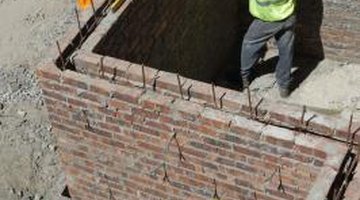The Name of the Style of Home Built With Mortar Protruding From Brick
Brick provides homeowners with a number of advantages over some other exterior building material options. Brick homes tend to be cooler in the summer and warmer in the winter due to their thermal mass, which gives them the ability to absorb heat and then release it slowly. For bricks to perform at the highest level they must be properly joined together with mortar. Skilled brickmasons can lay brick using a variety of methods, including the weeping mortar method.
Joint Types

Apprentice brickmasons may learn a variety of joint types including concave joints, flush joints, rake joints, V joints, beaded joints and struck joints. Each of these techniques involves using the trowel or some other tool to scrape away or otherwise shape the mortar. An exception to these methods is the weeping mortar joint, which involves laying the next layer of brick on top of the mortar without scraping or molding it in any way. This allows the mortar to ooze, or weep, from between the layers of brick to create a distinctive finish as it dries.
Aesthetics
Weeping mortar joints can be found on a wide variety of home styles ranging from contemporary ranch homes to English Tudor-style to Swiss cottages. The style has both its advocates and detractors. Advocates recognize the style as requiring extraordinary skill on the part of the brickmason, and appreciate the apparently random 'weeping' pattern of the mortar. Detractors may claim the style looks sloppy and unfinished. The beauty of this type of mortar joint is in the eye of the beholder.
Purpose
The purpose of all exterior masonry joints is to hold the bricks together and to protect the interior of the home from weather penetration. Weeping mortar joints can be effective at these task while also resulting in an interesting appearance, provided the mortar is properly selected and installed by a skilled brickmason. The mortar makes up approximately 20 percent of the wall's surface, according to the Pine Hall Brick company, so it is important to choose the right mortar for the job. The best type of mortar for your home may vary based on the climate in your region of the country.
Considerations
Laying bricks using weeping mortar joints, sometimes referred to as extruded joints, is a recognized method for joining bricks. U.S. Tile includes the extruded joint method in its Best Practices Guide for installing bricks, but notes that concave joints, V joints, grapevine joints, weathered joints, flush joints and raked joints are more highly recommended for new construction, based on the method's level of water penetration and mortar compaction.
References
Writer Bio
Mike Parker is a full-time writer, publisher and independent businessman. His background includes a career as an investments broker with such NYSE member firms as Edward Jones & Company, AG Edwards & Sons and Dean Witter. He helped launch DiscoverCard as one of the company's first merchant sales reps.
Photo Credits
- Digital Vision./Photodisc/Getty Images
More Articles



